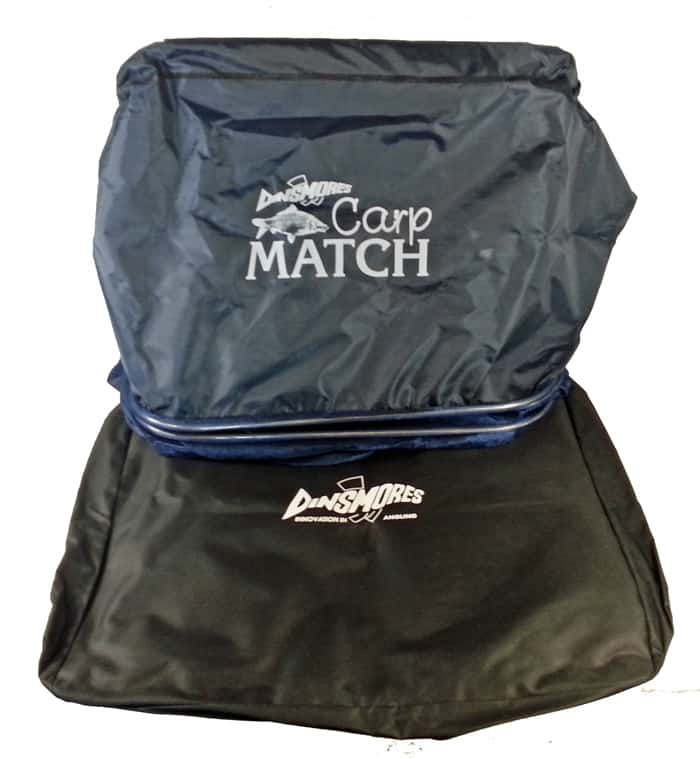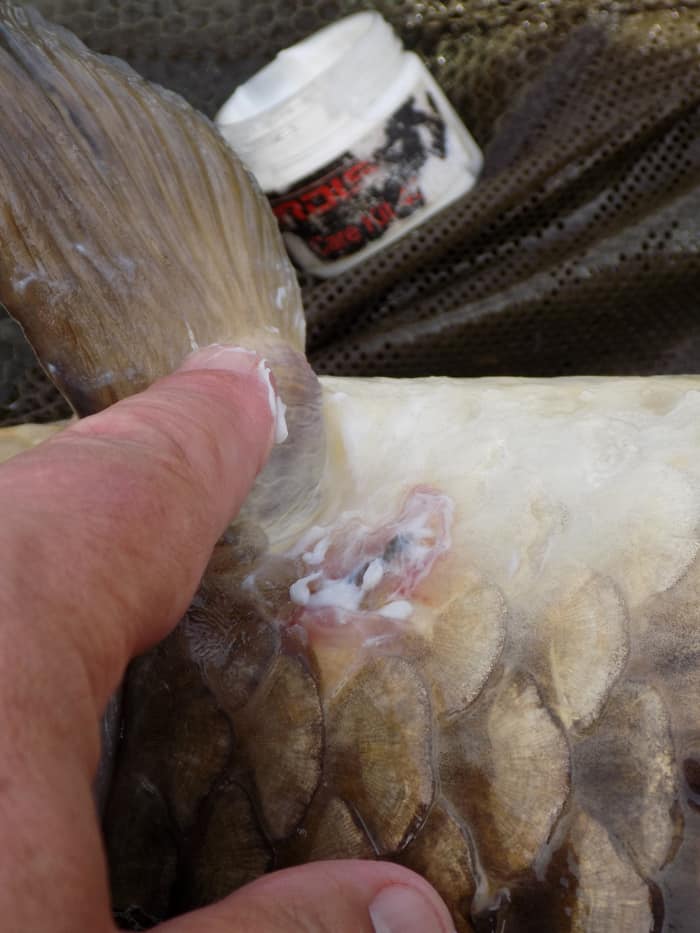Dovetail Live
Euro Fishing: Clint Walker - Fish Care

Fish care...caring for your catch...
I love reading through old angling books, many from the 1960's and 70's, catching up on tales which have made history, but sometimes, when I see what is being used, I cringe; thankfully, things have come a long way since then, and looking after your catch has become much easier, and thankfully, expected...
I look back at when I first started fishing, some 36 years ago, and realise that now, fish care is at the forefront of most (sadly not all) angler's minds when they seek out big fish, but I still see some woefully ill prepared to deal with a decent fish, and in truth, some anglers still put catching above caring, which is terrifically sad...
So, what has changed? Gone are the days of knotted nets. No longer do we see coarsely meshed nets which acted like cheese graters, stripping scales and cracking fins, keepnets have to be at least six feet long, and all landing nets are now constructed with super soft, knotless mesh which is far better for fish, and far easier to keep clean to prevent the spread of waterborne diseases. Unhooking mats are now available to prevent damage to flanks and fins, enabling the fish to remain protected from unseen hazards in long grass, and 'carp care' kits now seem to be the norm on many fisheries. One of the things I'm really glad to see the back of is the pike gag; what a monstrosity that thing was! Spring loaded, and designed to force open the jaws of the unfortunate pike, it took no account of the size of fish, and could cause huge damage when jammed between the teeth of the unfortunate beast... thankfully, for most anglers, things have moved on...
But why is it important to be prepared? Well, fish welfare is of course paramount to any self-respecting angler. I know we all catch them by means of a sharp hook, but mitigating damage, and promoting recovery, should be at the front of every angler's mind when on the bank. If it isn't at the forefront of your angling, then please take up golf...
Before you fish, be prepared; it's that simple, and there really is no excuse. An unhooking mat, thickly padded, should be one of your first purchases. I've lost count of the number of anglers I've seen with expensive rods and reels, who spend a fortune on bait, in order to catch the largest resident in the lake, but have absolutely nothing with which to care for the fish! A decent mat can be bought for less than £20, and anything is better than nothing. Many fisheries now insist on a mat or cradle, and if you haven't got one, then quite rightly, you're not allowed to fish. Personally, I have at least four mats; a cheap roll up one for light lure fishing when perch are my target, a wide, padded mat for bream and tench, a zip up pad for my pike fishing, and a huge, soft cradle with walls to prevent specimen carp bouncing all over the bank, and none of them have broken the bank, or any of my captures!

It's unfortunately inevitable, that during the ensuing tussle with a fish, that a scale may be damaged, the tail may be scraped, and during spawning, you may notice many cuts and grazes caused by their amorous endeavours. Thankfully, many companies now supply a number of products to treat such injuries, ranging from small sprays to thicker creams, which can be applied to encourage healing, and protect from infection. They can be dabbed on with cotton buds, smeared with a finger, and sprayed over the area, but all have the same purpose. Admittedly, some are expensive, and don't necessarily work better than others, but anglers have been using Bonjela for years too, a cheap alternative which really should form part of your kit. I use Vardis Tackle Carp Care Cream, a lanoline based product which I'm confident enough to use on myself too. Many times, I've nicked a finger on a pike's tooth, or scuffed a knuckle on sharp gill rakers, or even, when I got a size 8 barbed in my middle finger, once wrenched free with forceps, the cream was applied to stop the bleeding, and keep it clean! Get some!

Tools are another thing I see lacking sometimes. Novice pike anglers, excited by their first foray into the predator world, often neglect to consider what they are going to do when they actually hook one, bank it, and then have an angry crocodile thrashing in the net whilst they look on forlornly, unable to remove a deeply embedded treble! I can't stress enough the need to be 'tooled up' when pike fishing! A bare minimum pike kit should consist of long forceps, long nosed pliers, and most importantly, side cutter pliers to snip any hook which needs it. Unhooking pike can be a tricky evolution, especially if you get your bite indication wrong, so be properly prepared, and don't forget to take spares; don't chance it if you've misplaced your forceps. I don't use a glove either, preferring to feel exactly where my hand is under the gill plate, but it's all about confidence... if it goes wrong, I've got plasters, and carp care cream!

What else? Nets should be considered as part of your fish care. It's no good angling for big fish with a small net, and any net you do use should be deep enough, and wide enough, to fully support your catch. Nets with removable arms will help safely transport your fish from the water to the waiting unhooking mat, and back again, but it's important to ensure that your prize is properly laid out, with fins against the body, not folded beneath where they are likely to snap, before the fish is lifted, so take a few seconds to check. Try not to weigh your fish in the net, but instead use a dedicated weigh sling which will ensure the fish is laid out properly, fully support the weight, and negate the chance of fins or scales being damaged. It's extra expense, but worth it. Keepnets; I rarely use a keepnet, unless I have to get a particular shot for a magazine feature or similar, but even then, try to retain as few fish as possible, and will often spread them between a couple of nets so I can be sure there is enough room to circulate freely. I may alienate a few readers here, but I disagree completely with match anglers putting large carp into keepnets, and then tumbling them down the net into the weigh baskets at the end of the session to rest on each other, further compressing their delicate structures. What makes it worse is that they pose for the 'catch shot' with a rubberised bag of large fish, resting on a gravel or concrete bank! I've lost count of the amount of fish I've seen with torn dorsal fins, smashed pectorals, and damaged flanks caused in this way, but as I mentioned, some put catching before caring... sorry about that.

Time is also an important consideration when fishing; your catch should be out of the water for the absolute minimum amount of time. This means getting set up properly to remove, unhook, protect and photograph your fish, before returning it safely. It helps to get your camera tripod set up, with a few test shots fired, so you know exactly where to kneel when you take your picture. It's no good catching your big fish, then messing about setting it up, it needs to be done before you get the bite, so it's ready to go! Lay out your unhooking mat, tools, and care kit, set up the tripod, unfurl your landing net, and be sure it's all in place before you cast out! I've known anglers drag fish down the bank to my swim to borrow my landing net as they haven't pieced theirs together before fishing! You also need to give your fish time to recover. A few minutes resting in the margin in the net, or if needs must, a retaining sling, will give hard fighting fish such as barbel and grayling ample time to get their breath back after a spirited scrap.

A few other things are common sense; don't stand up with any large fish. If you drop it, it may appear unhurt, but the internal organs may be damaged beyond repair, and it will swim off only to go 'belly up' an hour later. Use your loaf, support the fish a few inches above the mat, that's what it's there for, to protect the fish if it flips away from you. Use suitable tackle too, it's not fair to seek out big fish on light tackle, where you have a chance of getting smashed up, leaving terminal tackle trailing, which can wrap around an underwater obstacle and tether the fish. We've all heard about 'death rigs', there is enough information out there to ensure rig safety, so use it. Don't be the one to cause a death or damage through ignorance...it really isn't an excuse any more, though sadly, it's why many fisheries have to conduct 'rig checks'. Use wet hands to handle fish, not a towel, or gloves, as you will strip off the protective slime which covers the fish. Spikey perch and ruffe can cause injury, but if you slide your hand down from the head to trap the gill plates and dorsal spikes when unhooking, there is no need to envelop them in a towel!

I think I've covered most aspects, but to recap, get a mat, pick up some carp care medication, use the right tools, select the appropriate tackle and nets, and use a bit of common sense. Look after your fish, you take on that charge when you start fishing, so don't neglect it... you are the custodian on the bank, it's your responsibility...
0
0
0
0
Dovetail Live
6y
Euro Fishing: Clint Walker - Fish Care
Bassmaster Fishing 2022
2y
Bass to the Future: The Story So Far
The Catch
3y
The Catch: Carp & Coarse Out Now
Fishing Sim World
4y
What Is Fishing Sim World: Pro Tour?
Fishing Sim World
4y
Fishing Sim World: Pro Tour Purchase Options
Fishing Sim World
5y
Clint Walker - Pike fishing with Deeper Sonar
Fishing Sim World
5y
Clint Walker - Single Hook Pike Rigs
Fishing Sim World
5y
Clint Walker - Looking for dace on the River Trent
Fishing Sim World
5y
Clint Walker - Looking for Zander
Fishing Sim World
5y
Clint Walker - Change of plans and somewhere new
Fishing Sim World
5y
Clint Walker: Tench and Bream at Rode Pool
Fishing Sim World
5y
Net yourself a deal in the Dovetail Games Publisher Weekend
Fishing Sim World
5y
Clint Walker - Trying Out The Sonik SKSC Range
Fishing Sim World
5y
Clint Walker - Carp in the Park
Euro Fishing
5y
Euro Fishing: Great Deals in the Autumn Sale
Fishing Sim World
5y
Spooky Ghost (Carp) Steam Halloween Sale
Fishing Sim World
5y
Clint Walker - Back at Home
Fishing Sim World
5y
Clint Walker - Fishing in Australia
Fishing Sim World
5y
Clint Walker - Deeper Sonar Fishing
Fishing Sim World
5y
Clint Walker - Carp-talk and Australia
Fishing Sim World
5y
October Dovetail Fishing League Tournaments
Fishing Sim World
5y
Clint Walker - A Wander Up The Canal
Euro Fishing
5y
Euro Fishing: Ultimate Edition Complete my Collection
Euro Fishing
5y
Euro Fishing: PS4 Double Discount Sale
Euro Fishing
5y
Euro Fishing: PlayStation Europe Summer Sale
